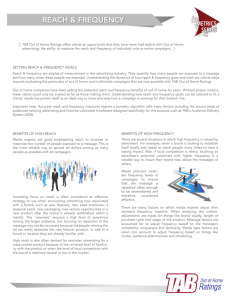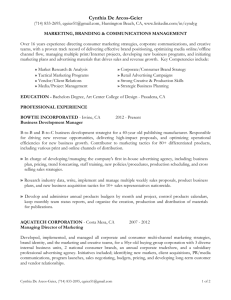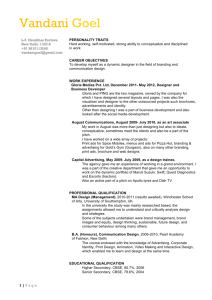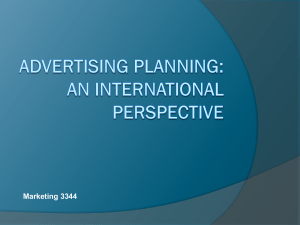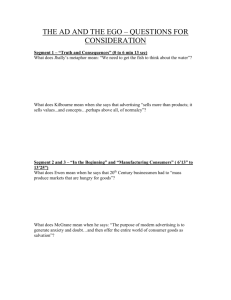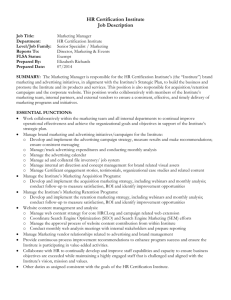Marketing Communication
advertisement
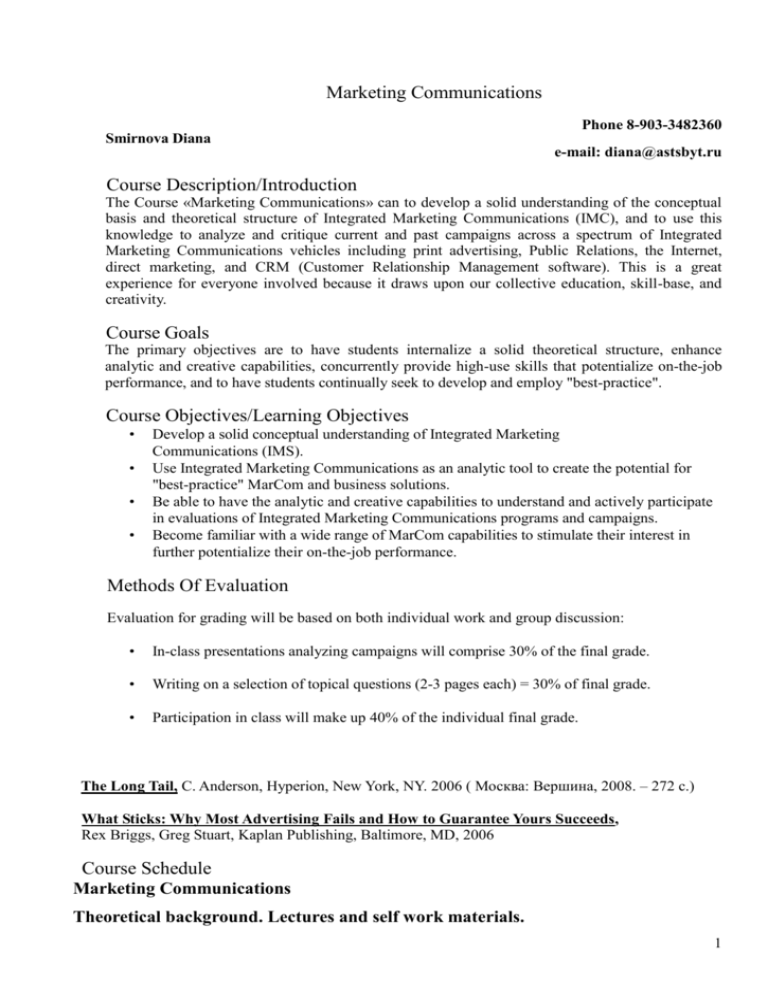
Marketing Communications Phone 8-903-3482360 Smirnova Diana e-mail: diana@astsbyt.ru Course Description/Introduction The Course «Marketing Communications» can to develop a solid understanding of the conceptual basis and theoretical structure of Integrated Marketing Communications (IMC), and to use this knowledge to analyze and critique current and past campaigns across a spectrum of Integrated Marketing Communications vehicles including print advertising, Public Relations, the Internet, direct marketing, and CRM (Customer Relationship Management software). This is a great experience for everyone involved because it draws upon our collective education, skill-base, and creativity. Course Goals The primary objectives are to have students internalize a solid theoretical structure, enhance analytic and creative capabilities, concurrently provide high-use skills that potentialize on-the-job performance, and to have students continually seek to develop and employ "best-practice". Course Objectives/Learning Objectives • • • • Develop a solid conceptual understanding of Integrated Marketing Communications (IMS). Use Integrated Marketing Communications as an analytic tool to create the potential for "best-practice" MarCom and business solutions. Be able to have the analytic and creative capabilities to understand and actively participate in evaluations of Integrated Marketing Communications programs and campaigns. Become familiar with a wide range of MarCom capabilities to stimulate their interest in further potentialize their on-the-job performance. Methods Of Evaluation Evaluation for grading will be based on both individual work and group discussion: • In-class presentations analyzing campaigns will comprise 30% of the final grade. • Writing on a selection of topical questions (2-3 pages each) = 30% of final grade. • Participation in class will make up 40% of the individual final grade. The Long Tail, C. Anderson, Hyperion, New York, NY. 2006 ( Москва: Вершина, 2008. – 272 с.) What Sticks: Why Most Advertising Fails and How to Guarantee Yours Succeeds, Rex Briggs, Greg Stuart, Kaplan Publishing, Baltimore, MD, 2006 Course Schedule Marketing Communications Theoretical background. Lectures and self work materials. 1 1. Basic notions of integrated marketing communications. 1.1. American and Russian integrated marketing communications development notion history. 1.2. Marketing communications mode. 1.3. Integrated marketing communication component. 2. Brand role in marketing communications. 2.1. Segmenting and positioning; 2.2. Brand structure and branding; 2.3. Analysis macro and micro of ambience of enterprise. SWOT - analysis; PEST analysis; Strategic matrixes; 2.4. Best brand success history and efficient re-branding examples. 3. Marketing communication systems developments (improvement) on new (acting) enterprises examples. 3.1. Structure Development of integrating marketing communication system with provision for given strategic analysis, chosen segment and criterions of positioning. 3.2. Enterprise house style formation. Integrated marketing communications places of sale (Merchandising). 3.3. Creating a loyal customer program. 3.4. Public relations. PR - activity organization. Marketing stimulation as marketing communications instrument. 3.5. Direct marketing as an instrument of marketing communications. 3.6. Efficient companies advertising development. Marketing communications media-planning. 3.7. Integrated marketing communication system presentation. Summation. 2 Section 1. “Basic notions of integrated marketing communications”. Lesson №1. Subject: “American and Russian integrated marketing communications development notion history”. Topics to prepare home tasks and to be discussed in auditoriums: Advertisement development main stages, public relations, sale stimulations and direct marketing. Marketing communication system tools origin. Marketing communication system tools development in Europe and in the USA. Marketing communication system tools development in Russia. Marketing communication system tools role and value in modern conditions. Short discussion about the integrated marketing uses. Introduction to the databases; their strategy, purpose, task list, structure, possible advantages. How do they contribute to integrated marketing efficiency work improvement? Planed tasks for auditoriums work: Business play. Play topic: "Discussing a condition and prospects of market of marketing communications in Russia" The Listeners are divided into groups of 3 to 5 persons each. Estimated participants are: marketing communications agencies’ groups, experts’ group, customers’ group. Mass media group. After 30 minutes discussion the groups representatives have to express and show its standpoint on the changes which have occurred in the agency, the mass media and as a whole in society for the last 5 years and which will occur in the nearest 5 years. From 5 to 10 minutes are devoted to each presentation. At the End of the play the general trends of marketing communications market must be revealed. During the discussion it is necessary to take into account regional specificities. Material: Markers and one whatman papers for each group. Lesson № 2. "Communications in marketing model". Topics to prepare home tasks and to be discussed in auditoriums: Communications theory. Communications notions. Enterprise marketing communications scheme. Sender description, report description, recipient description, coding and decoding processes, response and feedback as marketing communication elements scheme. 3 Efficient marketing communications shaping principles. Barrier (noises) description and methods reducing their influence. Task Using the example of acting enterprises consider and work out a conclusion on marketing complex (marketing-mix) structure efficiency. Estimate marketing communications system role and its contents as marketing complex element in the enterprise. Conduct an analysis to substantiate the chosen purposes and marketing communication system task. Lesson № 3. "Integrated marketing communication component". Topics to prepare home tasks and to be discussed in auditoriums: Discussing about marketing communications methods: advertisements, ties with the public, direct marketing, information electronic sources, Internet. Enterprise communication policy structure. Interpersonal intercourse instruments. Non-private intercourse. Marketing communication System as a non-private intercourse instrument. Marketing communication system in the enterprise addressees. Marketing communication system tools categorization. Practical task Work out conclusions about different types of marketing communications expediency using, having considered existing marketing communications in the following groups of enterprises and goods (services) example: 1) Mass demand industrial goods; 2) Consumer demand Goods; 3) Narrow profile commercial enterprise; 4) Mass services nonprofit enterprise; 5) Nonprofit enterprise, affording seasonal special-purposed goods. The 1 and 2 appendix give a based on types of used material and marketing communication facilities division resources categorization promotion. The most expedient customer in your opinion should be written down in front of each type of marketing communications. 4 Section 2: Brand role in marketing communications. Lesson № 4. Topic: "Segmenting and positioning" Topics to prepare home tasks and to be discussed in auditoriums: Market segment notion. Segmenting criterions. Efficient segment leading indexes. Segmenting methods. Positioning in competitive market notion. Two positioning strategies. Five parameters in differentiation. Efficient positioning criterion main features. Practical tasks Task. A company in saling its goods configures on three market segments. The volume of sales in the first segment during the last period reached 8 mil. items as the market capacities in this segment was 24 mil. items. The market capacity in this segment is supposed to increase of 2%, as the company share is to rise of 5%. In the second segment the company share was 6%, as the sales volume was 5 mil. items. The market capacity increases of 14% while the company share remains the same in this segment. The third segment the market capacity market was 45 mil. items, the company share was 0,18. No changes were to be foresighted. Define the company sale volume this year under the said conditions. Lesson № 5. Topic: " Brand structure and branding" Topics to prepare home tasks and to be discussed in auditoriums: Brand notion and feature. Branding notion. Brand shaping main stages. Trade mark notion. Trade mark main functions. Main types of trade marks. Trade mark development and registrations process. Trade mark legal requirements list. Trade mark advertisement capability. Brand creation cost evaluation. Task Choose 2-3 successful brands and carry out an analysis of a few separate elements. Appreciate the efficiency reasons. 6. "Analysis macro and micro of ambience of enterprise. SWOT - analysis; PEST 5 analysis; Strategic matrixes" Topics to prepare home tasks and to be discussed in auditoriums: Main marketing matrixes strategies BCG, Ansoff, Poppy-rings, Competitive advantages. SWOT - analysis; PEST - analysis. Michael Potter 5 powers system. Task. Choose a new industry segment and two companies that are recognized as strong competitors in that segment. Analyze the integration level of the campaigns from the standpoint of as many marketing vehicles as you can find including print ads, direct mail, exhibitions, seminars, the Web, electronic media (radio/TV), CDs, promotions, etc. This should be done in Powerpoint and will be presented and discussed in class. Use examples in the presentation. Lesson № 7. "Best brand success history and efficient re-branding examples" Topics to prepare home tasks and to be discussed in auditoriums: Brand efficiency criterion. "Вrand valuation" and "brand evaluation". The three most prime examples of domestic re-branding stories: Faberlic: "The Muscovite with European look (2001). Aeroflot: At first planes, afterwards come girls (2002). Beline: Striped revolution (2005). World successes and re-branding collapses. British Airways rebranding. Pepsi-Cola: the last party’s decisions in colour (1998). LG: export model (1995) Marlboro: sex-change operation (1955). Market brands Leaders: Coca-Cola, Google and Microsoft. Task. Cite successful and collapse re-branding samples in Russia and in the world practice. 6 Section 3: Marketing communication systems developments (improvement) on new (acting) enterprises examples. Exercise № 8. "Structure Development of integrating marketing communication system with provision for given strategic analysis, chosen segment and criterions of positioning". Topics to prepare home tasks and to be discussed in auditoriums: Promotion whole campaigns and product features (attributes) influence on eligible elements of integrated marketing communication system. Goods life cycle and their stages. Using the main and synthetic marketing communications tools system at the following steps of goods life cycle: introduction, growing, maturity and decline. Marketing communications in commercial and nonprofit structures. Task. For a chosen market segment and in the existing competitions conditions choose positioning and develop trade mark element (brand) criterion. If it is necessary choose a re-branding direction (for an existing trade mark). This presentation should be done in Powerpoint and will be presented and discussed in class. Exercise № 9. "Enterprise house style formation. Integrated marketing communications places of sale (Merchandising). Topics to prepare home tasks and to be discussed in auditoriums: Branded enterprise style. Branded style advantages. Enterprise branded style main elements. Integrated marketing communications purposes and problems at places of sale. External and internal integrated marketing communication facilities in places of sale. Merchandising notion. Merchandising main purposes and directions. Packing role in merchandising. Trade personnel of shop role and working in merchandising. Task Develop a branded style elements as packing and other merchandising elements on a chosen product. Exercise № 10. " Creating a loyal customer program". Topics to prepare home tasks and to be discussed in auditoriums: Customer’s behavior bases (making a buying decision, the person drawing a 7 conclusion, stages of buying, style of consumption). Categorization of enterprise by consumer . Confident and loyal buyer. Loyalty level evaluation. Level service evaluation by user. Clients loyalty premises. Loyalty support methods. Users informing facilities. Task Develop a user maintenance loyalty program on a chosen product. Its volume should not be less than 2 pages. Exercise № 11. " Public relations. PR - activity organization. Marketing stimulation as marketing communications instrument". Topics to prepare home tasks and to be discussed in auditoriums: Advertisement advantages and disadvantages and sponsorship as Public relation guidelines. Consultancy, лоббизм and product-placement as Public relation additional directions. Enterprise marketing stimulation guidelines: final consumers stimulation, intermediaries and business partners stimulation, enterprise trade personnel stimulation. Valued and non-valued new marketing stimulation methods. "Hard" and "mild" marketing stimulation. Description of concrete tools to assist sales, directed on users: reductions, discount card, coupons, bonuses, free samples, tasting, new goods testing, contests, lotteries, games, goods "reinforcement", packing. Marketing stimulation actions planning, organization and checking. Promotion-campaigns and promo-share notions. Promotion-campaigns stages. Task Describe a PR strategy and write down an approximate action list for marketing stimulation. The volume of such a paper should not be less than 5 pages. Exercise № 12. "Direct marketing as an instrument of marketing communications". Topics to prepare home tasks and to be discussed in auditoriums: Types of direct marketing: personal sale, marketing direct-mail, telemarketing, telephone marketing, Internet-marketing. Purposes and general features of direct marketing communication. Direct marketing traditional campaign conduction Algorithm. Personal sale feature and stages. Selection and buyers choice methods. How to conduct sales presentations. How to conduct trade counsels. How to conduct trade seminars. 8 Marketing system network. Task Describe the direct marketing strategy for a chosen product, with compulsory use of Internet direct marketing. The volume of such a paper should not be less than 4 pages. Exercise № 13. "Efficient companies advertising development. Marketing communications media-planning". Topics to prepare home tasks and to be discussed in auditoriums: Notion of advertising campaigns. Purposes of advertising campaigns. Classification of advertising campaigns. Organization and stages of advertising campaigns principles. Advertising address notion. Advertising message conception process. Approaches to a creative advertising process. Creativity value in advertising. Advertising psychological development models (AIDA, ACCA, DIBABA, DAGMAR, "Approval", "strong advertisment" model. "weak advertisment" model, VIP model, communication model). Optimum facilities choice in spreading information criterion to achieve the whole marketing communications. Main requirements and approaches to media-plan development. Media carriers choice. Task Chose an advertising strategy and companies media-plan marketing to describe a chosen product. The volume of such a paper should not be less than 4 pages. Exercise № 14. "Integrated marketing communication system presentation. Summation". 9
